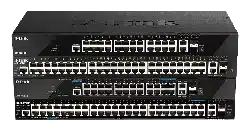Loading ...
Loading ...
Loading ...

DGS-1520 Series Gigabit Ethernet Smart Managed Switch Web UI Reference Guide
306
Parameter Description
hello messages, then the router with the highest IPv6 address will be
elected as the DR. By default, this value is 1.
Select the Default option to use the default value.
Hello Interval
Enter hello message interval value here. The range is from 1 to 18000 seconds. A
PIM router learns PIM neighbors via the hello message. Routers configured for IP
multicast send PIM hello messages to detect PIM routers. For SM, hello messages
are also used to determine which router will be elected as the designated router for
each LAN segment. By default, this value is 30 seconds.
Select the Default option to use the default value.
Join Prune Interval
Enter the Join/Prune message interval value here. The range is from 1 to 18000
seconds. When configuring the Join/Prune interval, the user needs to consider the
factors, such as configured bandwidth and expected average number of multicast
route entries for the attached network or link (for example, the period would be
longer for lower-speed links, or for routers in the center of the network that expect
to have a larger number of entries).
For SM-mode, the router will periodically send the join message based on this
interval. The hold-time in a Join/Prune message is 3.5 times the join-prune-
interval. The receiving router will start a timer based on this hold-time, and prune
the interface if no join message is received on this interface.
By default, this value is 60 seconds.
Select the Default option to use the default value.
BSR Domain Border
Select to enable or disable the BSR domain border feature here. When an
interface is configured as a border, it will prevent bootstrap router (BSR) messages
from being sent or received through it.
PIM Passive Mode
Select to enable or disable the PIM passive mode for this interface here. This
feature only takes effect when the interface is IPv6 PIM enabled. When the
passive mode is enabled, the interface will neither send PIM messages out nor
accept PIM messages from this interface. The router will act as it is the only PIM
router on the network. Use this feature only when there is only one PIM router on
the LAN.
Click the Apply button to accept the changes made.
Click the Back button to return to the previous window.
PIM for IPv6 BSR Candidate Settings
This window is used to display and configure the IPv6 PIM BSR candidate settings. This feature only affects PIM-SM
operation. This will cause the router to send bootstrap messages to all its PIM neighbors, with the address of the
Loading ...
Loading ...
Loading ...
